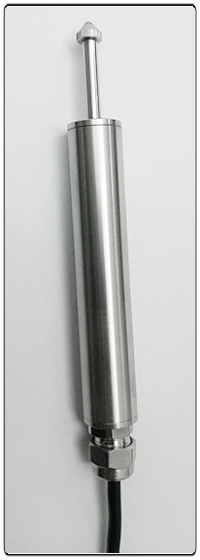Advantages
 Advantages of the LDS strain gauge (full bridge)
Advantages of the LDS strain gauge (full bridge)
displacement sensor for linear measurement
Versatility
LDS displacement sensors operate equally well on AC or DC signal conditioning and indicating systems as well as strain indicators and data logging equipment; the low noise, low power consumption characteristics of the LDS displacement sensors also provide microprocessor based instrument systems with high accuracy precision linear sensing facilities, at considerably lower cost than that of less accurate and noisy transformer type LVDT sensors. Output signal from the standard sensor range is mV/V but sensors can also be sold with either 4-20mA, 0-5V or 0-10V output options.
Compatibility
LDS Sensors operate at similar voltage levels and produce output signals compatible with other commonly used strain gauge sensors i.e. load cells, pressure transducers, torque sensors, accelerometers etc. LDS displacement measurements can readily be included with all or any of these parameters being processed by one central instrument system with multi-channel facilities. Alternatively LDS displacement sensors will operate on low cost AC or DC strain indicators, transducer indicators or digital volt meters. Standard AC LVDT transducers require intermediate conversion of both input and output signals in order to achieve similar compatibility with other transuding devices, which can elevate costs to well above that of direct LDS sensor connection for displacement measurement.
Accuracy
LDS displacement sensors exhibit typical non-linearity errors at least half that of errors typical of standard LDVT transducers. LDS displacement sensors resolution is infinite, as with other strain gauge devices, also strain sensitivity is constant with the input voltage range of 1.5 to 10 volt stabilised.
Reliability
LDS sensors are complete precision assemblies contained within a rugged stainless steel outer casing. On all models the spindle guide bearing and spring return are integral and the spindle return force is maintained at a minimum level for effective upside down operation without attaching the spindle to the subject. Whist the LDS sensors are designed and precision engineered for long life and excellent mechanical reliability, unlike most LVDT transducers, LDS sensors are completely serviceable by the manufacturer in the event of accidental electrical or mechanical damage in use.
Comparative Costs
Any transducer device would be quite useless without means of providing appropriate supply voltage and output signal indicating or monitoring equipment and usually this is by far the most costly part of any data acquisition programme. LDS displacement sensors provide instant linear measurement at considerably lower cost than LVDT measurement systems by utilising existing strain gauge signal inputs of indicators and data acquisition equipment. In this way the use of LDS displacement sensors limits expenditure to the cost of the sensor only, thus eliminating further capital outlay on dedicated instrumentation.
